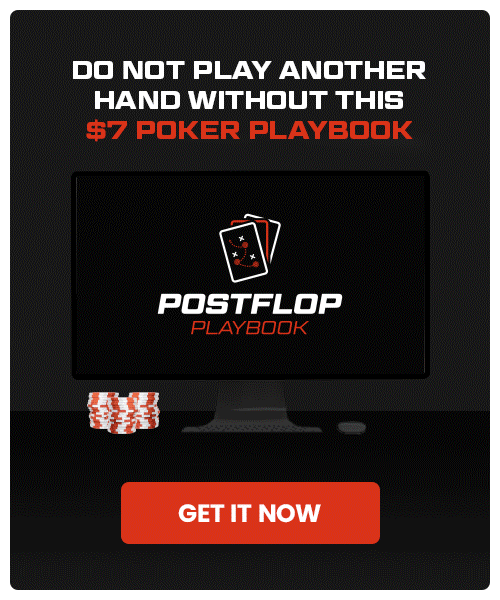How to Play King-Queen Offsuit in Cash Games
King-Queen offsuit is a powerhouse hand…in most scenarios.
It should be quite a money-maker for you (on average), but you need to know how to play it properly.
This article covers:
- How to Play King-Queen Offsuit Preflop
- 3 Tips for Playing King-Queen When You Miss the Flop
- 3 Tips for Playing King-Queen When You Hit the Flop
Let’s dive in!
Note: Do not play another hand without this $7 Postflop Playbook! With such a low price tag, Doug Polk’s Postflop Playbook is a no-brainer buy if you want to nail down your fundamentals and build a bigger bankroll. Level-up your poker skills now!
How to Play King-Queen Offsuit Preflop
Your position (and your opponents’ positions) is vital when considering how to play King-Queen offsuit.
These are the positions that will be referenced in this section:
Unopened Pots
Ranking among the top 15% of all No Limit Hold’em starting hands, King-Queen offsuit is strong enough to raise from all positions when the action folds to you.
At a 9-handed table, specifically, one could argue that King-Queen offsuit should be folded from the first two positions (UTG and UTG+1). If you’re at a particularly tough table (or one with very high rake), you may want to throw King-Queen offsuit in the muck. But if you think you have an edge, you will probably profit by raising with it.
Limping with it is not a good move. You’ll just win smaller pots on average by doing that.
Against an Open-Raise
When facing a raise, you need to be aware of your opponent’s position and also your own.
You need to keep in mind that even though this hand is very strong in unopened pots, things change when someone has already raised.
If a player has already raised from one of the early or middle positions, King-Queen offsuit not always strong enough to contest the pot profitably.
To be precise, this hand is usually worth 3-betting in the following scenarios:
- Middle position raises, you’re seated in the Cutoff
- Middle position, Hijack or Cutoff raises, you’re seated on the Button (you can also cold-call with it here)
- Cutoff or Button raises, you’re seated in the Small Blind
- Button raises, you’re seated in the Big Blind
- Small Blind raises, you’re seated in the Big Blind
Pro tip: This advice assumes that you’re playing against players with decent preflop strategies. If you are playing against weaker, recreational players, you can start calling or, even better, 3-betting to isolate them even from the rest of the positions that weren’t mentioned.
Against a 3-Bet
King-Queen offsuit is not a great hand with which to call a 3-bet unless the opponent’s range is wide. If you raised from the Button and the Small or Big Blind 3-bets, for example, King-Queen offsuit is worth calling.
King-Queen offsuit is, however, a decent 4-bet bluff candidate. It has blockers to strong hands, reducing the number of Pocket Kings and Pocket Queens combinations in half. Plus the number of Ace-King combinations to 75%.
The hand works especially well as a 4-bet bluff when the 3-bettor’s range is slightly wider. Crucially, should your opponent hold Ace-Queen offsuit (which dominates you), they will likely fold versus your 4-bet, which greatly increases your expected value.
Against a 4-Bet
When facing a 4-bet, you should always fold King-Queen offsuit. It is simply too weak to continue.
Note: Want to get better at poker without spending a lot of time or money? Get the $7 crash course that will help you win more often. Grab your Postflop Playbook now!
3 Tips for Playing King-Queen Offsuit When You Miss the Flop
These tips will help you navigate postflop with King-Queen offsuit when the flop does not contain a King or Queen.
Tip #1 – After defending your Big Blind, you can oftentimes call a c-bet with just two overcards
After defending from the Big Blind, you will often miss the flop completely. But unless the flop is Ace-high, that doesn’t mean that you should give up on the pot right away.
When you have two overcards, you still have a decent chance (12%) to hit a top pair on the turn and that chance doubles (24%) if you see the river as well. You may also be able to steal the pot away if your opponent checks back on the turn.
Should you check and face a small or medium bet from one of the looser positions (Hijack, Cutoff or Button), these two overcards can be worth a call.
To give a concrete example, suppose you defend your Big Blind against a Button raise with and the flop comes . You check and your opponent bets 75% pot. You should always check-call King-Queen offsuit in this situation.
Tip #2 – After 3-betting before the flop, c-bet even with two bare overcards when you’re in position (almost every time)
After 3-betting, you find yourself almost always having the range advantage on the flop. This happens because you have a ton of overpairs and your opponent doesn’t.
You can leverage that range advantage to bluff when you miss the flop. Because of your range advantage, your opponent will not be able to counter you, even if he was familiar with your overall strategy.
The only exception here is when the board is low and very coordinated. If the flop is something like or , you will have so many missed overcards and (almost) no flopped sets. Because of this, you cannot leverage that overpair advantage.
Tip #3 – If you miss the flop completely and the flop has a straight or flush already possible, it’s best to check on the flop
I’m talking about hands like on boards such as or .
Because the board is so connected and overall better for the caller’s range, your strategy should be more passive in these situations. Thus, checking becomes the better option.
If you have a backdoor flush draw to go with a backdoor straight draw, then c-betting becomes a more attractive option. But if you’ve completely whiffed and your opponent has a lot of strong hands, like on the example flops above, start with a check.
3 Tips for Playing King-Queen Offsuit When You Hit the Flop
Tip #1 – Check with your strong second pairs
For example: You raise preflop with , one player calls and the flop is .
When your middle pair can’t become a third pair — which is always the case with King-Queen — there isn’t an incentive to bet for protection. You also don’t get that much value from worse hands by betting. These two factors combine to make checking the clear option.
You can always start going for some value on the turn and/or river if your opponent shows weakness. Plus, you give your opponent the change to take a stab at the pot, and you’ll be able to call with your strong second pair.
Tip #2 – Always fast-play your strong hands
Missing out on value bets is like going to work and then not accepting your salary at the end of the week.
You do all this work — making risky bluffs, marginal calls, tough folds — and then you don’t charge your opponent when you have the goods. It doesn’t make any sense!
You should always start working on building the pot as soon as possible with your strong hands. When you flop two pair, trips, or a straight, you should always fast-play your hand.
The one possible exception is on a or flop. Since you have the deck so crushed on those flops, you can consider checking sometimes to let your opponent catch up and/or bluff.
Tip #3 – Flopped top pairs are mandatory c-bets
A top pair on the flop is a very strong hand that’s worth quite a bit of value. You can extract that value by c-betting when you’re the player who raised preflop.
Top pair with King-Queen is a particularly strong top pair. This increase in equity compared to weaker top pairs makes betting clearly better than checking.
This means that when holding King-Queen offsuit on a or type of flop, it’s a good idea to start building the pot right away.
Final Thoughts
King-Queen offsuit can be a very profitable hand if you play it in the right scenarios and in the right way. Just be sure to show discipline by folding it before the flop in the situations described above.
As with every piece of poker strategy, context is most important. So keep your mind sharp and focus strongly when playing.
That’s all for this guide. I hope you learned something new from it and if you found it useful please leave a comment in the section down below to show your support.
What starting hand would you like to see Upswing Poker cover next?
Let me know in the comments below.
You can see all the starting hand articles we’ve ever published right here.
Till’ next time, good luck, grinders!
When you get The Postflop Playbook, you will learn how to make quick and profitable decisions that translate to more (and bigger) winning poker sessions. Learn more now!

